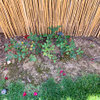For Henry Kuska
jim1961 / Central Pennsylvania / Zone 6
14 years ago
More Discussions
Henry,
I watched the video link you posted on Anti-Transpirants.
http://www.5min.com/Video/Learn-about-Anti-Transpirants-30449984
-----------------------------------------------------------
I'm willing to experiment on a container rose that is known to be blackspot prone.
But, I need alittle help from you. Which anti-transpirant should I use? Where's the best place to purchase it? I need to know the proper mixture for the product.
I did find a article that says this about Cloud Cover.
http://www.recyclenow.org/less-toxic/Roses.PDF
" ¥ Antitranspirants such as Cloud
Cover¨ or Wilt Pruf¨ and horticultural
oil (Sunspray Ultrafine¨) have been
observed to provide roses with protection
from fungal diseases. They create
a thin coating that can prevent spores
from fungal diseases from invading the
leaves. Treatment is begun when new
leaves appear in spring and must be
repeated whenever you see new
growth. Cloud Cover¨ in its ready-touse
form is too strong for roses. The
concentrate can be mixed 1 part Cloud
Cover¨ to 12 parts water to prevent
burning. Use a 1% solution of horticultural
oil and water (about 3 tablespoons
of oil in 1 gallon of water)."




henry_kuska
jim1961 / Central Pennsylvania / Zone 6Original Author
Related Professionals
Arnold Landscape Architects & Landscape Designers · Beavercreek Landscape Architects & Landscape Designers · Montgomeryville Landscape Architects & Landscape Designers · Saint Matthews Landscape Architects & Landscape Designers · Suffern Landscape Architects & Landscape Designers · Middletown Landscape Contractors · Edwardsville Landscape Contractors · Kaneohe Landscape Contractors · Long Branch Landscape Contractors · Mastic Beach Landscape Contractors · Post Falls Landscape Contractors · Stallings Landscape Contractors · Woodland Landscape Contractors · North Hills Landscape Contractors · Ansonia Landscape Contractorshenry_kuska
michaelg
jim1961 / Central Pennsylvania / Zone 6Original Author
karl_bapst_rosenut
mori1
henry_kuska
jim1961 / Central Pennsylvania / Zone 6Original Author
henry_kuska
olga_6b
henry_kuska
olga_6b
henry_kuska
mori1
henry_kuska
ramblinrosez7b
jim1961 / Central Pennsylvania / Zone 6Original Author
henry_kuska
jim1961 / Central Pennsylvania / Zone 6Original Author
henry_kuska
mori1